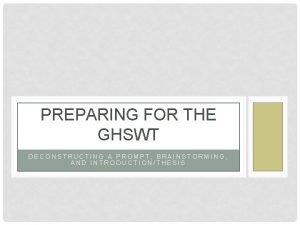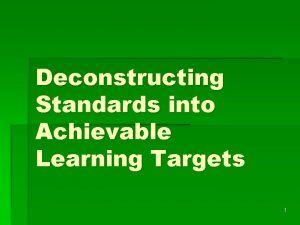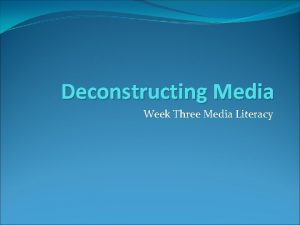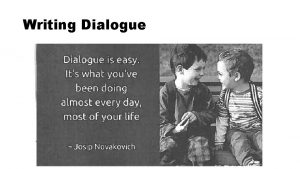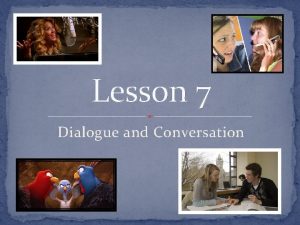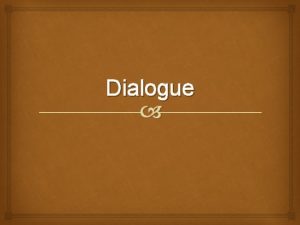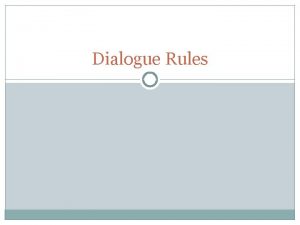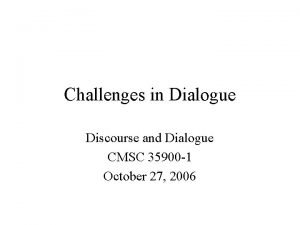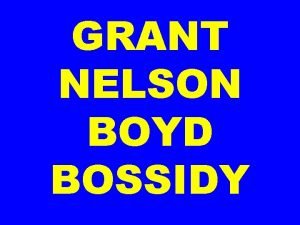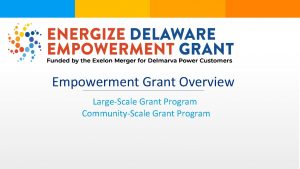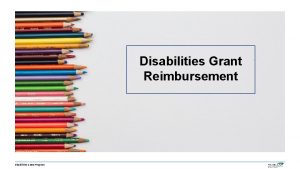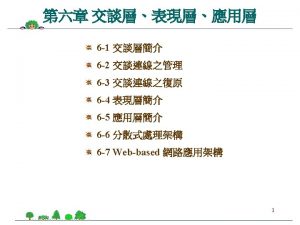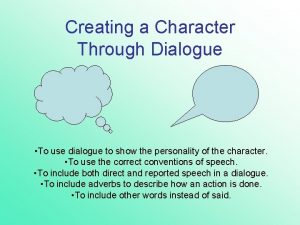Dialogue With Funders Deconstructing the Challenges of Grant




























- Slides: 28

Dialogue With Funders: Deconstructing the Challenges of Grant Writing Introduction to Evaluation Presented by: Sheree Shapiro Health Promotion Specialist Toronto Urban Health Fund Toronto Public Health

What is Evaluation? • Systematic collection & analysis of information • Activities, characteristics, results of programs to: • make judgments; • to improve program outcomes/program • • effectiveness, to report outcomes to funders, to identity strengths and weakness, inform decisions about future programming; or increase understanding 2 Source: Patton 2008 and M. Gassanov (Program Evaluator, Toronto Public Health)

Research vs. Evaluation • • Research Generalizable knowledge Controlled Data integrity is primary Purpose is to advance a body of knowledge • • • Evaluation Aids decision making Changing resources/ priorities/context Pragmatism is primary Stakeholder focused Multiple uses Source: https: //web. stanford. edu/group/design_education/wikiupload/2/27/Helen_Evaluation. pdf

Basic Steps of Evaluation Step 1: Identify and engage stakeholders Step 2: Describe the program Step 3: Design the evaluation “Focus” the evaluation Step 4: Collect the data Step 5: Analyze the data Step 6: Report the results, develop plan for implementation of recommendations, and disseminate 4 Source: CDC and M. Gassanov (Program Evaluator, Toronto Public Health)

Step 1: Who needs to be involved? Ask yourself these questions: 1. 2. 3. 4. Who is affected by the program? Who is involved in program operations? Who will use evaluation results? Who requested the evaluation? Stakeholders can be • Evaluation or program-related • Internal or external • Direct relationship with the program or evaluation (e. g. , staff and clients) or have a indirect relationship (e. g. , advocacy groups) 5 Source: CDC and M. Gassanov (Program Evaluator, Toronto Public Health)

Step 1: Sample grantee evaluation: all stakeholders Who is affected by the program? Community Peer workers Volunteers Partnering agencies • Other non-profit agencies • Universities • Government partners Who is involved in program operations? Staff and management Peer workers Volunteers Who will use the evaluation results? Staff and management Other agencies Who “wants” the evaluation? Funder 6 ED

Step 1: Narrow your list to key stakeholders Those who • Will authorize continuation/expansion/changes of the program • Will advocate for the program • Are responsible for the day-to-day implementation of the program • Can increase the credibility of the evaluation 7 Source: CDC and M. Gassanov (Program Evaluator, Toronto Public Health)

Step 1: Potential roles for key stakeholders Information Hands-on support Decision-making / approval Advisory role Being an advocate for the evaluation 8

Step 1: Where in the evaluation process should we engage stakeholders? • At all stages! • • Program description Defining evaluation purpose Formulating evaluation questions Defining quality and value Gathering evidence Making recommendations Action planning 9

Step 2: Describe the program Why describe the program? • Make assumptions and expectations about the program clear • Explore competing understandings and develop consensus • Helps to ensure that your stakeholder list is complete • Leads to an informed discussion about what aspects of the program should be evaluated Source: Preskill and Jones 10

How to describe the program: Questions to answer 1. What is the problem/opportunity your program aims to address? 2. Who is the target population? 3. What resources will your program rely on? 4. What will your program do? What are your activities, services, and products? 5. How will participants benefit? 6. What is the program’s stage of development? 7. What are relevant contextual factors? 11 Source: CDC

Step 3: Designing the Evaluation Process Evaluation Outcome Evaluation Answers the questions: Answers the question: 1) How MUCH did we do? • Reach • Fidelity 1) • • • 2) How WELL did we do it? • Satisfaction • Use of developed resources/program Is anyone BETTER OFF? Knowledge Skills Behavior Intent to change Clinical change

Step 3: Evaluation Questions • Help provide a well defined, meaningful evaluation • Not the questions you ask participants How many servings of fruits & vegetable should you eat each day? Did participants increase their knowledge of healthy eating? Evaluation Question How many servings of meat & alternatives should you eat each day? How big is one serving of whole wheat pasta?

Step 3: Evaluation Questions • ‘Big-picture’ questions PROCESS Evaluation Questions OUTCOME Evaluation Questions 1) How many people did we reach? 1) Did participants increase their knowledge of HIV? 2) Did we implement the program as planned? 2) Did participants increase their self confidence to be physically active? 3) Are participants satisfied with the workshops? 3) How did participants change drug use behaviours?

Activity: Develop 2 process and 2 outcome evaluation questions! The Toronto AIDS Coalition is seeking funding for a project to provide safer sex workshops for gay/bi/MSM. The objectives of their project are: • To increase knowledge of HIV in 300 gay/bi/MSM from July 2015 -June 2016 in neighbourhood xyz. • To increase confidence to negotiate safer sex in 300 gay/bi/MSM from July 2015 -June 2016 in neighbourhood xyz. They plan to provide a survey and feedback form at the end of the workshops.

Step 3/4: Types of Methods Please see “evaluation methods” resource in your package.

Step 3/4: Types of Methods QUANTITATIVE QUALITATIVE - Numbers - Words - Statistics - Stories - Surveys - Demographics - Attendance - Focus groups - Interviews

Step 3/4: Survey and Tracking Tools • Fluid Surveys • Survey Monkey • Google Forms • Interceptum • Lime Survey • Simple Survey • Poll Daddy

Step 3/4: Selecting your evaluation type and methods When choosing your methods consider: 1. Reliability 2. Validity 3. Accessibility 4. Feasibility • Time • Resources 5. Stakeholder perspectives 6. Evaluation ‘burnout’ 7. Ethical issues

Activity The Toronto AIDS Coalition is seeking funding for a project to provide safer sex workshops for gay/bi/MSM. The objective of their project is: • To increase knowledge of HIV in 300 gay/bi/MSM from July 2015 -June 2016 in neighbourhood xyz. To measure this objective, they plan to do a FOCUS GROUP in June 2016 with 8 participants.

Activity The Toronto AIDS Coalition is seeking funding for a project to provide safer sex workshops for gay/bi/MSM. The objective of their project is: • To increase confidence to negotiate safer sex in 300 gay/bi/MSM from July 2015 -June 2016 in neighbourhood xyz. To measure this objective, they plan to do a pre and post survey about confidence to negotiate safer sex (before and after the workshop)

Step 3/4: Making your evaluation plan Evaluation Question Indicators Methods Timelines How many people did we reach? # of youth attending workshops # of youth reached at outreach events - Attendance tracking - Outreach tracking sheet At the beginning of each workshop (monthly) Are participants satisfied with our workshops? % of participants who liked the workshop - Workshop satisfaction survey End of each workshop Did participants increase their knowledge of diabetes prevention? % of participants who increased their knowledge of preventing diabetes through healthy eating -Workshop knowledge survey End of each workshop % of participants who increased their knowledge of preventing diabetes through physical activity At the end of each outreach (weekly)

Step 5: Data analysis Quantitative Simple: Data entry into Excel Use formulas for averages, percentages, etc. Qualitative Simple: Content Analysis (see resource in your package) Simpler: Online survey tools automatically provide summaries Talk to your funder about the level of analysis needed for the application and reporting.

Step 6: Dissemination • Consult with stakeholders • Ensure usability • Consider the reader • Follow funding guides to ensure reporting is done in the manner the funder requires

Step 6: Reporting 1. What did you do (survey, focus group, etc. )? 2. When did you do it (after workshop, before & after workshop)? 3. What was the purpose (to determine community need, to determine knowledge gained, etc. )? 4. # people involved? 5. Which people (youth, staff, people who inject drugs, parents, etc. )? 6. What were the results? • • Quantitative (# or %) Qualitative (themes with quotes or paraphrased quotes)

Step 6: Reporting/Applying example We conducted oral surveys with 50 sex workers, during outreach sessions from March. June, 2014 to determine whether sex workers felt confident to negotiate safer sex with their clients. We found that 90% said that they did not feel confident to ask their clients to use a condom and 80% did not know how to use a female condom. In addition, 100% wanted to learn more skills to negotiate safer sex, and 85% stated that one on one education sessions would be the best way to gain those skills.

References Davidson, Jane E. 2012. “Actionable Evaluation Basics: Getting succinct answers to the most important questions [minibook]. U. S. Department of Health and Human Services. Centers for Disease Control and Prevention. 2011. “Introduction to program evaluation for public health programs: A self-study guide. ” Atlanta, GA: CDC. University of Wisconsin-Extension, Cooperative Extension. 2008. “Building capacity in evaluating outcomes: A teaching and facilitating resource for community-based programs and organizations. ” Madison, WI: UW Extension, Program Development and Evaluation. (UWEX) Canadian Evaluation Society. Essential Skills Series Workbooks. November 2011. Fitzpatrick, J. L. , J. R. Sanders, and B. R. Wothen. 2011. “Program Evaluation: Alternative Approaches and Practical Guidelines. ” Pearson Education. Preskill, Hallie and Darlene Russ-Eft. 2005. “Building Evaluation Capacity: 72 activities for teaching and training. ” Thousand Oaks, CA: Sage Publications, Inc. Preskill, Hallie and Nathalie Jones. 2009. “A Practical Guide for Engaging Stakeholders in Developing Evaluation Questions. ” Robert Wood Johnson Foundation Evaluation Series. Taylor-Powell, Ellen, Sara Steel, and Mohammad Douglah. 1996. “Planning a Program Evaluation. ” 27

Questions/Comments? Contact: Sheree Shapiro Health Promotion Specialist Toronto Public Health sshapir@toronto. ca 416 -338 -0917 28
 Open research funders group
Open research funders group Expressions of congratulation
Expressions of congratulation What does raft stand for
What does raft stand for Notes on deconstructing the popular stuart hall
Notes on deconstructing the popular stuart hall Deconstructing a prompt
Deconstructing a prompt Deconstructing standards
Deconstructing standards Deconstructing writing prompts
Deconstructing writing prompts Deconstructing media examples
Deconstructing media examples ưu thế lai là gì
ưu thế lai là gì Sơ đồ cơ thể người
Sơ đồ cơ thể người Tư thế ngồi viết
Tư thế ngồi viết Hình ảnh bộ gõ cơ thể búng tay
Hình ảnh bộ gõ cơ thể búng tay đặc điểm cơ thể của người tối cổ
đặc điểm cơ thể của người tối cổ Cái miệng xinh xinh thế chỉ nói điều hay thôi
Cái miệng xinh xinh thế chỉ nói điều hay thôi Mật thư tọa độ 5x5
Mật thư tọa độ 5x5 Tư thế ngồi viết
Tư thế ngồi viết Gấu đi như thế nào
Gấu đi như thế nào Thẻ vin
Thẻ vin Thể thơ truyền thống
Thể thơ truyền thống Các châu lục và đại dương trên thế giới
Các châu lục và đại dương trên thế giới Từ ngữ thể hiện lòng nhân hậu
Từ ngữ thể hiện lòng nhân hậu Diễn thế sinh thái là
Diễn thế sinh thái là Slidetodoc
Slidetodoc Thế nào là giọng cùng tên? *
Thế nào là giọng cùng tên? * Vẽ hình chiếu vuông góc của vật thể sau
Vẽ hình chiếu vuông góc của vật thể sau 101012 bằng
101012 bằng Khi nào hổ con có thể sống độc lập
Khi nào hổ con có thể sống độc lập Lời thề hippocrates
Lời thề hippocrates Chụp tư thế worms-breton
Chụp tư thế worms-breton




